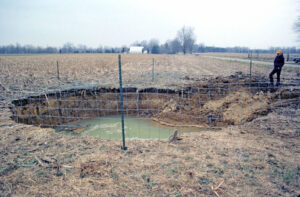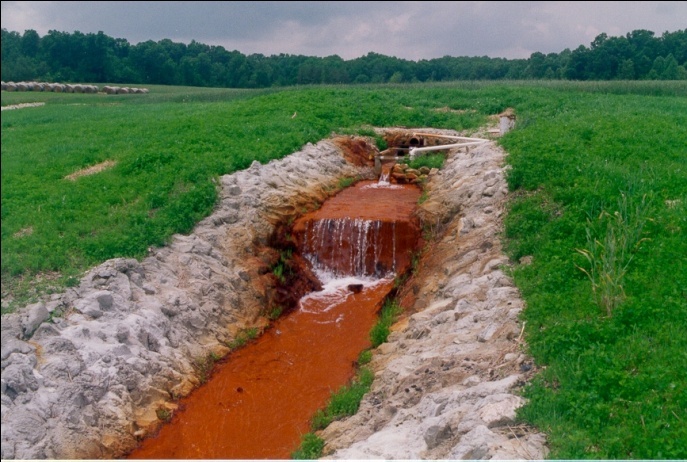More than 900 million tons of coal has been removed from underground mines in southwestern Indiana, and more than 194,000 acres are underlain by such mines, most of which are abandoned. In places, as many as three different coal beds were mined (referred to as multiseam mining).
Most folks know about the acid mine runoff that poisons rivers and creeks (usually identifiable by their bright orange color), but subsidence—often in the form of sinkholes—is also a major problem. Many of the underground mines are very shallow. Among 756 hoist shafts for which depths are recorded, 651 (86 percent) are less than 200 feet; the maximum recorded depth is only 506 feet.
The underground coal mines of Indiana are all room-and-pillar mines, and, while some operations practiced full recovery with pillar removal, most practiced partial mining. Consequently, 20 to 50 percent of the coal on a property was left as pillars.
 Although partial mining was adopted to reduce the effects of subsidence, the collapse of roof strata above voids can occur intermittently and unpredictably for decades or centuries after mining has ceased. When subsidence occurs, the overlying land is subject to development of both sinkhole and sag-type subsidence.
Although partial mining was adopted to reduce the effects of subsidence, the collapse of roof strata above voids can occur intermittently and unpredictably for decades or centuries after mining has ceased. When subsidence occurs, the overlying land is subject to development of both sinkhole and sag-type subsidence.
In Indiana, sinkholes may exceed 25 feet in depth and involve the downward movement of as much as 500 cubic yards of unconsolidated sediments. Sinkholes generally occur where mines are less than 150 feet in depth, but shallow sag-type subsidence can occur at depths down to and exceeding 450 feet.
Tens of thousands of Indiana housing units may overlie abandoned underground mines. Other infrastructure that is exposed to subsidence damage include as much as 90 miles of U.S. and State Highways and 66 miles of railroads, as well as dams, nursing homes, airports, a hospital, and a prison (Harper and others, in preparation). Only an inch of sag-type subsidence can cause serious damage to foundations and masonry structures, and even small amounts of subsidence can disrupt agricultural cultivation by disrupting field tiles and producing ponding. Alteration of the flow of ground water can also occur.
In a few places, attempts have been made to prevent the occurrence of subsidence by drilling into the abandoned workings and back-filling the voids. Such an approach is extremely expensive, and its effectiveness has never been proven. Home owners who live in or near undermined areas can obtain information about underlying mines from the Coal Mine Information System of the Indiana Geological Survey. For those residence or businesses that are undermined, insurance is available through the Indiana Mine Subsidence Program.
Now, on February 9, 2023, the U.S. Department of the Interior announced more than $24.6 million in fiscal year 2022 funding from President Biden’s Bipartisan Infrastructure Law to create well-paid union jobs, and catalyze economic revitalization, by reclaiming abandoned mine lands in Indiana.
Millions of Americans nationwide live less than a mile of an abandoned coal mine. The Bipartisan Infrastructure Law allocated a total of $16 billion to address legacy pollution, including $11.3 billion in abandoned mine land funding over 15 years, facilitated by the Office of Surface Mining Reclamation and Enforcement. This historic funding is expected to address the majority of inventoried abandoned coal mine lands in the nation, which will help communities address and eliminate dangerous environmental conditions and pollution caused by historic coal mining.
“President Biden’s Bipartisan Infrastructure Law has given us a historic opportunity to address legacy pollution in Indiana and across the country. The reclamation landscape of tomorrow presents endless opportunities for innovation, efficiency and partnership,” said Secretary Deb Haaland. “Reclaiming and restoring these sites will create jobs, revitalize economic activity, and advance outdoor recreation. I am so excited about what we can do with these new resources, today and for future generations.”
To date, nearly $677 million in awards have been announced for Alabama, Alaska, Arkansas, Colorado, Illinois, Iowa, Kansas, Kentucky, Maryland, Missouri, New Mexico, North Dakota, Ohio, Pennsylvania, Texas, Virginia, West Virginia, and Wyoming. Funding will be awarded to additional eligible states and Tribes on a rolling basis as they apply.
AML reclamation supports jobs in coal communities by investing in projects that close dangerous mine shafts, reclaim unstable slopes, improve water quality by treating acid mine drainage, and restore water supplies damaged by mining. It also enables economic revitalization by reclaiming hazardous land for recreational facilities and other economic redevelopment uses like advanced manufacturing and renewable energy deployment. As directed by the Bipartisan Infrastructure Law, funding will prioritize projects that employ dislocated coal industry workers.
This funding will enable states to remediate abandoned mines that are leaking methane – a key contributor to climate change. This comes as part of the Biden-Harris administration’s unprecedented investments in coal, oil and gas, and power plant communities. This effort also advances the President’s Justice40 Initiative that commits to delivering 40 percent of the benefits of certain climate and clean energy investments to disadvantaged communities.
As required by the Bipartisan Infrastructure Law, funding allocations are determined based on the number of tons of coal historically produced in each state or on Indian lands before August 3, 1977, when the Surface Mining Control and Reclamation Act was enacted. States are guaranteed at least $20 million over the 15-year life of the program if their inventory of AML sites would cost more than $20 million to address. As state AML inventories are updated, future distributions may change.
These Bipartisan Infrastructure Law AML funds supplement traditional annual AML grants, which are funded by active coal operations. In the 45 years since SMCRA was enacted, OSMRE has provided more than $8 billion under the AML reclamation program to reclaim lands and waters that were mined or affected by mining prior to 1977.
Photos courtesy of Indiana Geological Survey. Featured photo shows acid mine runoff that kills streams.

